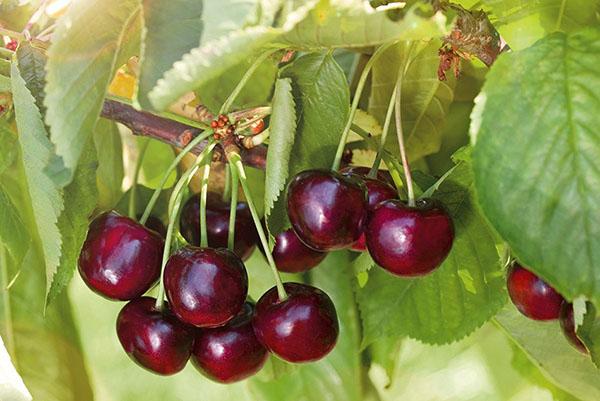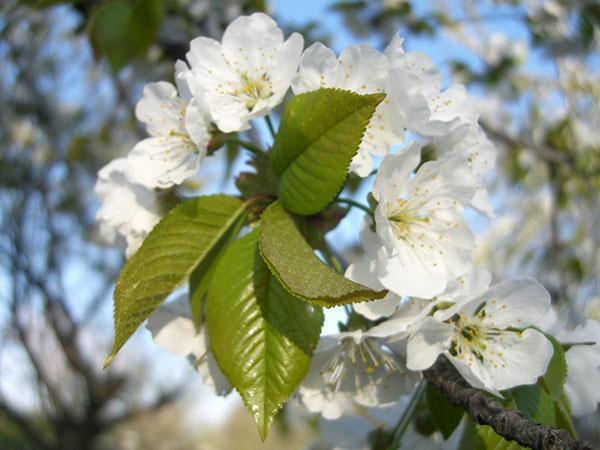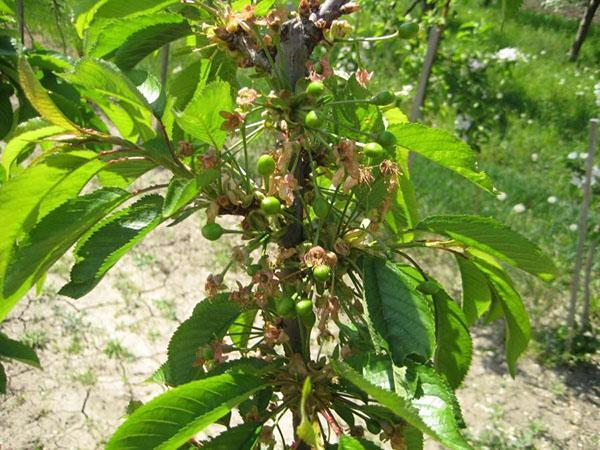Sweet cherry Iput - a variety of early ripening
 Sweet cherry is traditionally considered a thermophilic crop, most of whose varieties prefer the southern regions and the middle zone that does not tolerate winter. The exception is the Iput cherry bred by Russian breeders, the description of the variety, photos of fruiting trees and the experience of growing them speak of the hardy winter-hardy nature of the plants.
Sweet cherry is traditionally considered a thermophilic crop, most of whose varieties prefer the southern regions and the middle zone that does not tolerate winter. The exception is the Iput cherry bred by Russian breeders, the description of the variety, photos of fruiting trees and the experience of growing them speak of the hardy winter-hardy nature of the plants.
The history of the variety, intended for the center of Russia and the Central Black Earth region, began in the 80s of the last century in Bryansk. Using unnamed numbered hybrids for crossing, scientists from the All-Russian Research Institute of Lupine received seedlings of a new variety, which by 1993 had been tested and was recommended for inclusion in the State Register.
For the new variety of sweet cherries, Bryansk breeders have chosen a name that seems strange to many gardeners. In fact, the name was given to the variety in honor of the beautiful quiet river Iput, flowing through the expanses of the Bryansk and neighboring regions.
Description of cherry trees varieties Iput

As you can see in the photo of the Iput cherry, its shoots are covered with smooth large foliage of a dark green hue. The younger the branches, the larger the elongated, slightly ovoid leaf plates with a serrated edge and a dense petiole. The tip of the leaf is strongly pointed, and the base, on the contrary, is rounded. The outer side has a more intense color than the back, and the petiole often stands out with a reddish-brown tint, especially noticeable on large glands.
 According to the description of the variety, the Iput cherry, as in the photo, is characterized by early flowering, and large flowers are collected in small inflorescences of 3-4 pieces and are located on bouquet branches. The wide-open corollas are assembled from white contiguous petals. Strongly protruding from the narrow, goblet-like calyx, the stamens and pistil do not differ in length, which facilitates pollination.
According to the description of the variety, the Iput cherry, as in the photo, is characterized by early flowering, and large flowers are collected in small inflorescences of 3-4 pieces and are located on bouquet branches. The wide-open corollas are assembled from white contiguous petals. Strongly protruding from the narrow, goblet-like calyx, the stamens and pistil do not differ in length, which facilitates pollination.
The grown cherry seedlings of Iput are ready for fruiting by the fourth or fifth year of life. By this time, it is necessary to complete the formative pruning, otherwise there is a risk of being left without sweet fruits for another 1-2 years.
Features of fruiting cherry varieties Iput
 Dark red or almost black fruits ripening in the first half of summer, depending on weather conditions and care, can gain weight from 5 to 10 grams. A juicy drupe with a small ovoid bone, accounting for less than 5% of the total weight, has a medium-dense, rich red flesh. The juice of a ripe cherry, round-heart-shaped, is just as dark, aromatic and tasty. The light brownish stone is moderately adjacent to the pulp and is separated from it with little effort.
Dark red or almost black fruits ripening in the first half of summer, depending on weather conditions and care, can gain weight from 5 to 10 grams. A juicy drupe with a small ovoid bone, accounting for less than 5% of the total weight, has a medium-dense, rich red flesh. The juice of a ripe cherry, round-heart-shaped, is just as dark, aromatic and tasty. The light brownish stone is moderately adjacent to the pulp and is separated from it with little effort.
When fully ripe, the fruits keep well on strong short stalks, which allows you not to be afraid of losing part of the crop due to shedding.
All fruit crops are grown for the long-awaited harvest. Cherries of the Iput variety will delight you both with the number of fruits and their excellent quality.Juicy drupes are distinguished by their attractive appearance and excellent taste, which received a rating of 4.5 points from the experts. A handful of sweet cherries of this variety contain up to 11.5 mg of vitamin C. Per 100 grams of sweet cherries, there are:
- 16.6 grams of dietary fiber;
- 11 grams of sugars;
- 0.5 grams of acids.
The weight and sweetness of the fruits directly depend on the weather conditions, the chosen planting site and care for the Iput cherries. If the spring and summer turned out to be cold and little sunny, the ovary pours worse, and by the time it is removed from the tree it has a tart or barely bitter taste. Fruit cracking can result from abundant watering of ovary-strewn plants or a rainy period 2-3 weeks before harvest.
 In order for the culture to show itself in all its glory, the Iput variety requires pollinators, which are planted next to self-fertile trees. The selection of pollinators for Iput cherries is carried out taking into account the timing of flowering so that pollen from one plant can freely get to another.
In order for the culture to show itself in all its glory, the Iput variety requires pollinators, which are planted next to self-fertile trees. The selection of pollinators for Iput cherries is carried out taking into account the timing of flowering so that pollen from one plant can freely get to another.
Among the best neighbors for the Iput variety will be cherry trees Jealous and Bryansk pink, Ovstuzhenka, Raditsa and Tyutchevka. All of them are perfectly adapted to the conditions of central Russia, and their planting will help not only increase the yield, but also diversify it.
Advantages and weaknesses of the Iput cherry variety
Since the variety was created for the middle zone, increased winter hardiness should be attributed to the strengths of the Iput cherry. In the harsh winters of Bryansk and other nearby regions, no more than 60% of the trees froze, and about 80% of the flower buds remained on the shoots. That is, with the arrival of spring, the plants were covered with white flowers, bore fruit in summer and by autumn they successfully restored their losses.
The description of the variety and the photo of the Iput cherries indicate that the plantings are not very susceptible to diseases caused by fungi. If the fruits are affected by rot, this most often occurs in a cool, wet summer or if the rules of agricultural technology are not followed.
A huge plus of the variety is regular fruiting and excellent taste of early fruits. Cherry berries have a universal purpose, that is, they are equally good fresh and as part of home preservation.